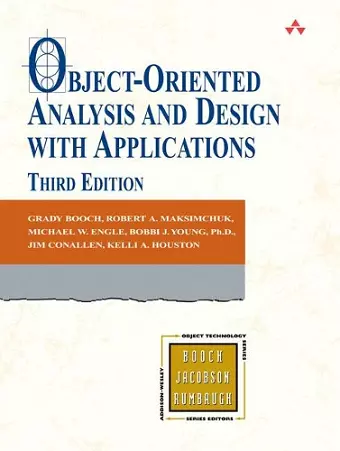Object-Oriented Analysis and Design with Applications
Michael Engle author Grady Booch author Robert Maksimchuk author Bobbi Young, PhD author Jim Conallen author Kelli Houston author John Fuller editor
Format:Hardback
Publisher:Pearson Education (US)
Published:16th May '07
Should be back in stock very soon

Object-oriented technology has evolved as a means of managing the complexity inherent in many different kinds of systems, and the object model has proven to be a very powerful and unifying concept. This book provides practical guidance on the analysis and design of object-oriented (OOAD) systems. It provides a sound understanding of the fundamental concepts and historical evolution of the object model, facilitates a mastery of the notation (UML 2.0) and process of OOAD, and teaches how to effectively use OO technology to solve real problems. In addition, the guide offers a collection of five nontrivial examples encompassing a diverse selection of problem domains. The book also includes supplemental material throughout the text including an appendix on OO programming languages, summary of features on a few common languages including C++ and Java, and a glossary of common terms. Appropriate for newcomers to OO and those with experience, this is a pragmatic book that addresses the practical needs and concerns of software engineers.
Teaches you to apply object-oriented methods using paradigms such as Java, the Unified Modeling Language (UML) 2.0, and .NET. This work gives an introduction to the new UML 2.0, from the notation's most fundamental and advanced elements with an emphasis on key changes. It also includes an appendix on object-oriented programming languages.
Object-Oriented Design with Applications has long been the essential reference to object-oriented technology, which, in turn, has evolved to join the mainstream of industrial-strength software development. In this third edition--the first revision in 13 years--readers can learn to apply object-oriented methods using new paradigms such as Java, the Unified Modeling Language (UML) 2.0, and .NET.
The authors draw upon their rich and varied experience to offer improved methods for object development and numerous examples that tackle the complex problems faced by software engineers, including systems architecture, data acquisition, cryptoanalysis, control systems, and Web development. They illustrate essential concepts, explain the method, and show successful applications in a variety of fields. You'll also find pragmatic advice on a host of issues, including classification, implementation strategies, and cost-effective project management.
New to this new edition are
- An introduction to the new UML 2.0, from the notation's most fundamental and advanced elements with an emphasis on key changes
- New domains and contexts
- A greatly enhanced focus on modeling--as eagerly requested by readers--with five chapters that each delve into one phase of the overall development lifecycle.
- Fresh approaches to reasoning about complex systems
- An examination of the conceptual foundation of the widely misunderstood fundamental elements of the object model, such as abstraction, encapsulation, modularity, and hierarchy
- How to allocate the resources of a team of developers and mange the risks associated with developing complex software systems
- An appendix on object-oriented programming languages
This is the seminal text for anyone who wishes to use object-oriented technology to manage the complexity inherent in many kinds of systems.
Preface
Acknowledgments
About the Authors
Section I: Concepts
Chapter 1: Complexity
Chapter 2: The Object Model
Chapter 3: Classes and Objects
Chapter 4: Classification
Section II: Method
Chapter 5: Notation
Chapter 6: Process
Chapter 7: Pragmatics
Chapter 8: System...
ISBN: 9780201895513
Dimensions: 237mm x 184mm x 42mm
Weight: 1240g
720 pages
3rd edition